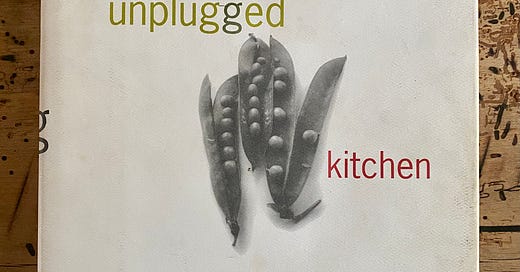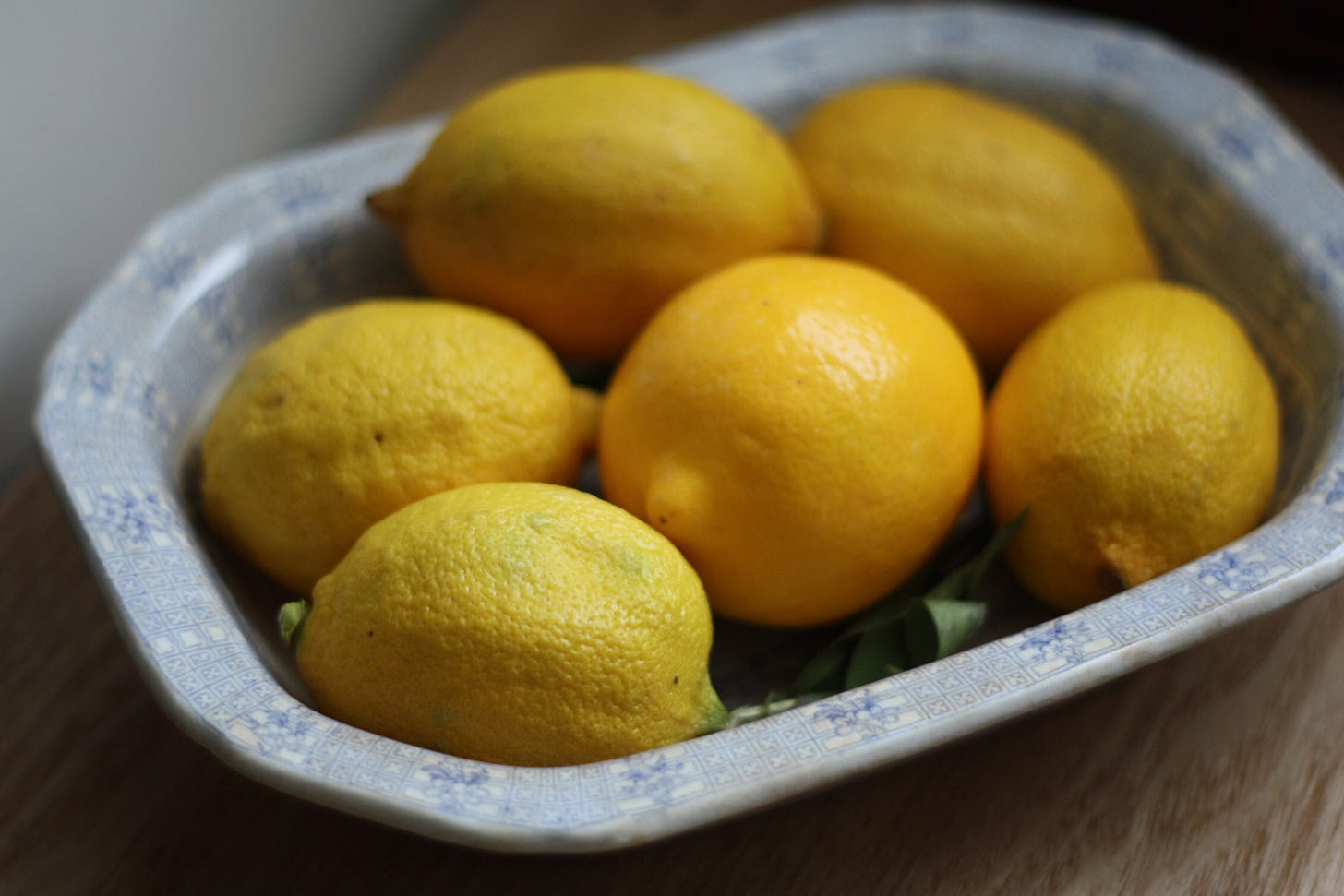A note to readers and subscribers:
Every month, I will be spotlighting a favorite book and author — usually food-related, but sometimes not; usually new, but sometimes not; easily found, but sometimes rare —- that has taken hold of my life and heart, and not let go. In the case of food books, I will include a selected recipe that I have come to know and love and that has become a fixture in my kitchen, in the hope that you will go out, find the book (hopefully at your local independent bookseller), and fall in love with it as much as I have. I will not be using formal publicity or press photos, but shots taken in my own home and kitchen, so you can see drips/dings/pages/notations/marks, which, I believe, are evidence of love and use.
Please support writers everywhere; in the world of John O’Donohue’s neon times and addiction to distraction, it is the interiority of words and thought that will save us, and writers — myself included — depend on you, often quite literally. Thank you.
The second in my Spotlight series is Viana La Place’s Unplugged Kitchen.
We are not hotel-stayers, Susan and I (and after getting stuck in a hotel elevator last night after my Brooklyn book event with the delightful Becky Vollmer, I probably won’t be for a while).
There are a lot of upsides to this, including renting cottages and houses in communities we really love, shopping in local farmers’ markets, cooking for ourselves, and having friends over for dinner. In 2010, we took a trip out to the Bay Area, and rented a lovely little place a few blocks from the center of Mill Valley. It was a dramatic jewel-box with deep red marble countertops in the kitchen — very Victorian, which is not usually our style — but it also had floor to ceiling bookshelves perpendicular to a lovely little breakfast nook. On the first morning we were there, we were having our coffee and tea, and I got up and pulled a book down from the top shelf. And for the ten days we were there, I never put it back.
I need to back up a little bit: for readers who don’t know, I spent many (many) years as an acquiring editor with a part-time writing habit (as opposed to being a writer with a part-time editing habit), and I often refer to myself as the author who knows too much: I know why some books disappear, why some books do well and others — despite amazing reviews and sold-out events — do not, why some books get support from their publishers and others do not, despite getting massive advances. On and on. I’d like to say that this knowledge has served me well and it mostly has; it’s also, for two out of three of my memoirs, given me migraines that required injectable medications. When it comes to cookbooks, though, when they disappear out of nowhere — they’re here and then they’re gone — it’s more than the stories that disappear with them. What falls into the abyss is the possibility of nurturing and sustenance and sometimes history at both the micro and macro levels. What disappears is the xeroxed, splattered page that you send to the daughter of your college roommate, who passes it along to her best friend, who gives it to her mother-in-law, who shares it with her neighbor. You get what I’m saying.
Okay, so, that out of the way:
Mill Valley, 2010, a little Victorian cottage, a floor-to-ceiling bookshelf in the kitchen, and a book that has me in its grips and won’t let me go. Viana La Place’s Unplugged Kitchen. Entirely vegetarian, mostly Mediterranean and primarily Italian, written by half of the duo that wrote the classic Cucina Fresca among other great books, before she disappeared into the mists, like James Earl Jones into the cornfield. The book’s subtitle is a sentence: A return to the simple, authentic joys of cooking. And that is what it is, in the most lovely of ways.
La Place’s requirements are less about expensive tools than about practical objects: wooden boards, a zester, a hand-cranked pasta machine, wooden spoons, a Moka espresso pot. Tea towels. She talks about the importance of keeping a clean kitchen, and the fact that it’s time to replace that chemical smell that we’ve come to associate with cleanliness. Some of the recipes include a sidebar called Don’t Throw It Away: citrus fruit peels are saved for candying or air-drying, or zested for salads, soups, rices, pastas, desserts; pasta water is saved for thinning an overzealous pesto; broccoli stems, trimmed and cooked until tender, are delicious. Others feature commentaries on unfortunate problems, like Pasta Under Attack, and the questions surrounding restraint (and lack thereof) in the modern American kitchen. An aside about children and food reminds the reader that young ones tend to be attuned to their body’s needs regarding when and how they eat, and have instinctual cravings (the rest of that sentence might be: and we would do well to respect that fact).
My first read-through was a strong reminder that no meal requires it be as expansive as we know “proper”meals to be in American culinary culture — meaning: main dish, side dish, other side dish — and instead can be comprised of a small bowl of a vegetable or two and some herbs and aromatics, like sauteed cauliflower with fresh cilantro, or green peas with lettuce, or poached zucchini with mint and garlic. La Place’s verdura cure for when she’s feeling unwell — boiled bitter greens cooked long enough to darken the water, which she sips all day, reserving the greens to be eaten with a little sea salt and some lemon juice — feels, for lack of a better word: wise.
This book should be a longtime classic, on every shelf of every home cook who loves vegetables and the idea of slow, intentional cooking.
When Susan and I returned home from Mill Valley, we ordered our own copy of this long out-of-print book, for which we paid the princely and unfortunate sum of $2.00; the postage was $3.00. (I say unfortunate because this book should be a longtime classic, on every shelf of every home cook who loves vegetables and the idea of slow, intentional cooking. The author, wherever she is — Viana, where are you? — should be getting a quarterly royalty check; I hope she is, but I’m almost positive she’s not.)
The moral of this story: when you see a battered cookbook on the shelves of your next rental house and you fall in love with it, order one for yourself and maybe another for someone you care about, and then talk about it as often as you can. Cook from it as if it were the hot new cookbook of the season. It might just change everything for you.
Recipe
Lemon and Green Olive Salad
from Unplugged Kitchen by Viana La Place
Olives and lemons—both are fruits, both sharply and vividly evoke aquamarine sea and that rough scrub of land called the Mediterranean. Little chunks of peeled lemon and slivers of green olive combine in a tangy and refreshing “fruit salad” that begs to be scooped up in a piece of torn flatbread or spooned onto a thick slice of crusty country bread.
From Poor Man’s Feast: We are not vegetarians in this house, but we love vegetables, and have often tossed this salad — really a relish — with room temperature spaghetti, torn basil, and shavings of a good, hard sheep’s milk cheese. We’ve also spooned it out onto grilled firm white fish like halibut, or even whole mackerel.
1 cup small green olives in brine, drained
2 lemons, preferably sweet Meyer lemons
4 tablespoons chopped flat-leaf parsley
1 tablespoon extra virgin olive oil
1/2 teaspoon ground cumin
Fine sea salt and freshly ground black pepper
Serves 4
Pit olives and cut in half lengthwise. Or use a paring knife to slice olive flesh off pit in thick strips.
With a vegetable peeler, remove thin yellow skin from lemons. Leave white pith, or at least some of it. (The sweet and nutritious pith keeps the lemon segments intact.) Cut lemons into horizontal slices and pick out seeds. Following the pattern of the flesh, cut lemon slices into small segments.
Toss the olives and lemons together, and season with remaining ingredients.







Just ordered a gently used copy. Thank you for the recommendation ♥️
Amazon let me know I ordered two copies of Unplugged Kitchen in Feb 2016 -- perhaps on your recommendation, not sure. I just looked at the recipe index from Poor Man's Feast and don't see it listed, so... a mystery. Anyway, my adult son and I love to read cookbooks before falling asleep, so I'm pretty sure he's the proud owner of one of my two 2016 copies. But where's mine?! Time to order another, thank you!